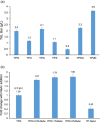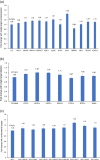Metabolic engineering of oleaginous yeast Rhodotorula toruloides for overproduction of triacetic acid lactone
- PMID: 35701887
- PMCID: PMC9540541
- DOI: 10.1002/bit.28159
Metabolic engineering of oleaginous yeast Rhodotorula toruloides for overproduction of triacetic acid lactone
Abstract
The plant-sourced polyketide triacetic acid lactone (TAL) has been recognized as a promising platform chemical for the biorefinery industry. However, its practical application was rather limited due to low natural abundance and inefficient cell factories for biosynthesis. Here, we report the metabolic engineering of oleaginous yeast Rhodotorula toruloides for TAL overproduction. We first introduced a 2-pyrone synthase gene from Gerbera hybrida (GhPS) into R. toruloides and investigated the effects of different carbon sources on TAL production. We then systematically employed a variety of metabolic engineering strategies to increase the flux of acetyl-CoA by enhancing its biosynthetic pathways and disrupting its competing pathways. We found that overexpression of ATP-citrate lyase (ACL1) improved TAL production by 45% compared to the GhPS overexpressing strain, and additional overexpression of acetyl-CoA carboxylase (ACC1) further increased TAL production by 29%. Finally, we characterized the resulting strain I12-ACL1-ACC1 using fed-batch bioreactor fermentation in glucose or oilcane juice medium with acetate supplementation and achieved a titer of 28 or 23 g/L TAL, respectively. This study demonstrates that R. toruloides is a promising host for the production of TAL and other acetyl-CoA-derived polyketides from low-cost carbon sources.
Keywords: 2-pyrone synthase; Rhodotorula toruloides; metabolic engineering; oilcane juice; triacetic acid lactone.
© 2022 The Authors. Biotechnology and Bioengineering published by Wiley Periodicals LLC.
Conflict of interest statement
The authors declare no conflict of interest.
Figures




Similar articles
-
Engineering acetyl-CoA metabolic shortcut for eco-friendly production of polyketides triacetic acid lactone in Yarrowia lipolytica.Metab Eng. 2019 Dec;56:60-68. doi: 10.1016/j.ymben.2019.08.017. Epub 2019 Aug 27. Metab Eng. 2019. PMID: 31470116
-
Engineering cofactor and transport mechanisms in Saccharomyces cerevisiae for enhanced acetyl-CoA and polyketide biosynthesis.Metab Eng. 2016 Jul;36:80-89. doi: 10.1016/j.ymben.2016.02.009. Epub 2016 Mar 9. Metab Eng. 2016. PMID: 26969250
-
Metabolic engineering of Rhodotorula toruloides IFO0880 improves C16 and C18 fatty alcohol production from synthetic media.Microb Cell Fact. 2022 Feb 19;21(1):26. doi: 10.1186/s12934-022-01750-3. Microb Cell Fact. 2022. PMID: 35183175 Free PMC article.
-
Current advances in alteration of fatty acid profile in Rhodotorula toruloides: a mini-review.World J Microbiol Biotechnol. 2023 Jun 26;39(9):234. doi: 10.1007/s11274-023-03595-3. World J Microbiol Biotechnol. 2023. PMID: 37358633 Free PMC article. Review.
-
Rhodotorula toruloides: an ideal microbial cell factory to produce oleochemicals, carotenoids, and other products.World J Microbiol Biotechnol. 2021 Dec 7;38(1):13. doi: 10.1007/s11274-021-03201-4. World J Microbiol Biotechnol. 2021. PMID: 34873661 Review.
Cited by
-
Nitrogen starvation causes lipid remodeling in Rhodotorula toruloides.Microb Cell Fact. 2024 May 17;23(1):141. doi: 10.1186/s12934-024-02414-0. Microb Cell Fact. 2024. PMID: 38760782 Free PMC article.
-
Perspectives for Using CO2 as a Feedstock for Biomanufacturing of Fuels and Chemicals.Bioengineering (Basel). 2023 Nov 26;10(12):1357. doi: 10.3390/bioengineering10121357. Bioengineering (Basel). 2023. PMID: 38135948 Free PMC article. Review.
-
Recent advances in genetic engineering and chemical production in yeast species.FEMS Yeast Res. 2025 Jan 30;25:foaf009. doi: 10.1093/femsyr/foaf009. FEMS Yeast Res. 2025. PMID: 40082732 Free PMC article. Review.
-
Decompartmentalization of the yeast mitochondrial metabolism to improve chemical production in Issatchenkia orientalis.Nat Commun. 2025 Aug 2;16(1):7110. doi: 10.1038/s41467-025-62304-w. Nat Commun. 2025. PMID: 40753087 Free PMC article.
-
Expanding the genetic toolbox of Rhodotorula toruloides by identification and validation of six novel promoters induced or repressed under nitrogen starvation.Microb Cell Fact. 2023 Aug 19;22(1):160. doi: 10.1186/s12934-023-02175-2. Microb Cell Fact. 2023. PMID: 37598166 Free PMC article.
References
-
- Abe, I. , Watanabe, T. , & Noguchi, H. (2005). Chalcone synthase superfamily of type III polyketide synthases from rhubarb Rheum palmatum . Proceedings of the Japan Academy, Series B, 81(10), 434–440. 10.2183/pjab.81.434 - DOI
Publication types
MeSH terms
Substances
Supplementary concepts
LinkOut - more resources
Full Text Sources
Miscellaneous

